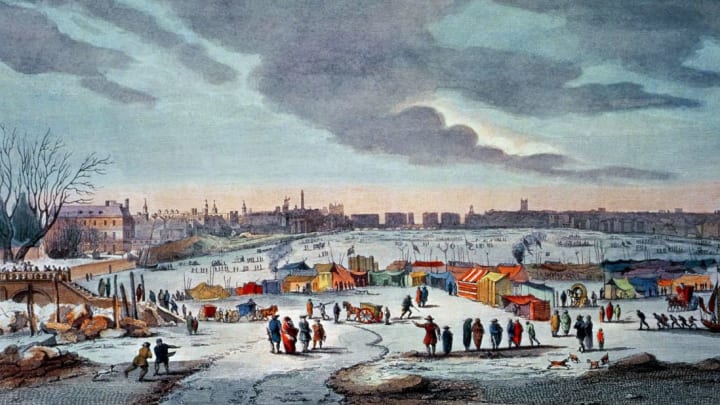During the winter of 1563, the River Thames froze into a solid sheet of ice. Queen Elizabeth I, availing herself of royal privileges, ordered her servants to set up an archery field on the frosty surface and tried her hand shooting at marks. Reportedly, she was a very good shot.
The unusual setting for the sport was forged by average winter temperatures in Europe that were as much as 2°C lower than today. The cold caused London’s main waterway to freeze into a thick platform for spectacular winter festivals called frost fairs. “Of booths there were a great number, which were ornamented with streamers, flags, and signs, and in which there was a plentiful store of those favorite luxuries, gin, beer, and gingerbread,” wrote George Davis, a London printer.
Is his 1814 book Frostiana: or A History of the River Thames in a Frozen State, Davis provides a first-hand account of one of these lively winter carnivals, during which Londoners abandoned the city streets and stepped onto the ice to indulge in food, spirits, and fun. A hedonist atmosphere prevailed: Men huddled around roaring fires to spin yarns while women filed into drinking tents to sip grog. Sporting enthusiasts, like Queen Elizabeth I, showed up for hare hunting, nine-pin bowling, and football, while fiddlers belted out jigs. The frozen wonderland was set against a backdrop of the 19-arch London Bridge and the irresistible aroma of spit-roasted meats. The fair even had its own main street: “The grand mall or walk was from Blackfriars Bridge to London Bridge; this was named ‘The City Road,’ and lined on each side with tradesmen of all descriptions,” Davis wrote.
the Little Ice Age

Frost fairs emerged during a nearly six-century-long cold spell—the Little Ice Age—when Europe experienced some of its coldest, harshest winters on record. The chill was brought on by a number of factors, including periods of low sunspot and volcanic activity in Indonesia that spewed sunlight-reflecting aerosols into the atmosphere and cooled temperatures. George Adamson, a lecturer in geography at King's College London, says fluctuations in the jet stream may have also played a role. “Sometimes we get larger ‘meanders’ in the jet stream which mean that the whole of the UK is located to the north of it,” he tells Mental Floss. “Within these conditions, colder air is brought in from Siberia.”
The hydrodynamics of the river also played a role. The old London Bridge’s closely spaced piers thwarted water flow, causing ice to build up beneath its stone archways. The bridge had a dam-like effect on the river, allowing it to freeze to the point where it could handle the weight of thousands of people—and even an occasional elephant—during the winter carnivals.
“The floating masses of ice with which we have already stated the Thames to be covered, having been stopped by London Bridge, now assumed the shape of a solid surface over that part of the river which extends from Blackfriars Bridge to some distance below Three Crane Stairs, at the bottom of Queen-street, Cheapside,” Davis reported.
Scenes at a Frost Fair
When the frigid winters brought the usual rhythms of commerce to a halt, frost fairs presented an economic opportunity for tradespeople and artisans. With their river routes were temporarily blocked with winter ice, ferrymen earned a few pence by offering sledge rides to fairgoers and selling books, toys, and trinkets from market stalls. Barbers, fruit peddlers, and goldsmiths also set up their shops on the ice. Printers hauled out huge clunky presses to crank out personalized fair tickets, poems, and cards that played up the novelty of publishing atop a frozen river. One of the frosty commemoratives read:
"Behold the river Thames is frozen o'er, Which lately ships of mighty burden bore; Now different arts and pastimes here you see, But printing claims the superiority."
The 1814 fair—the last known frost fair on record—might have been a welcome break for Londoners weary of hearing about Napoleon’s victories in Europe, according to historian Sean Munger. “London was not a fun place to live in 1814,” he tells Mental Floss. “The country was at war, the economy was depressed, and the king was insane. On top of that, there had been a terrible snow storm right before the fair that caused the city’s water mains to freeze and everything ground to a halt. The fair was kind of an escape where people could get away from their misery for a couple of days.”
The End of the Frost Fairs
As the 19th century wore on, it became less likely that thick ice would form on the Thames. The medieval London Bridge was torn down and replaced with a new one that allowed the river to flow more freely. In 1870, the Victoria Embankment was constructed along the Thames upstream from Blackfriars to relieve congestion on riverside streets, which narrowed the river and further increased its current. Along with milder winter temperatures, the new infrastructure made the frost fair of 1814 the last one on record.
Since then, the Thames has frozen over a few times—most recently in 1963. But whether frost fairs will ever return is anyone’s guess. As Earth’s climate continues to change and Europe gets warmer, the long-term outlook doesn’t look too cool.
